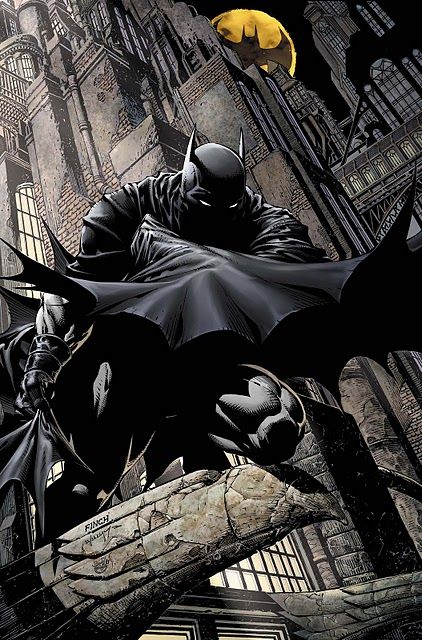The first of three $4.99 DC anniversary issues for the month of June, "Batman" #700 does not get the celebration going as much as you'd like. The quality of the actual comic presented here is higher than two-and-half stars, but the overall package of "Batman" #700 is sorely lacking. For your five dollars, you get 31 pages of story, seven pin-ups, and four pages of "Secrets of the Batcave." You barely cross the halfway mark as noted by the staples before the actual comic ends and you're left with the 'bonus' material. 'Bonus,' of course, is a highly malleable and subject term. The packaging of this book left a poor taste in my mouth, as it will for many others.
The actual story here is pretty good, though. Grant Morrison returns to "Batman" and teams with artists that he's worked with on the character before to tell a story that takes place over three different times with three different men wearing the cowl. Beginning with Bruce Wayne as Batman and Tony Daniel on art, Batman and Robin have been captured by a group of villains under the leadership of the Joker. They've been hooked into a 'maybe machine' invented by Professor Nichols and it will be used to unmake Batman, Robin, and all of the villains unless the bad guys are stopped.
This chapter is fun with Morrison channeling the goofy insanity of the Silver Age filtered through his sensibilities. Batman is a little harsher and darker than he's usually portrayed in these past stories, but it makes for a good contrast to the insanity of the Joker. Tony Daniel's art is messy, but energetic. His pages are cluttered as he tries to get everything in, but that lends itself to the chaos of the story. His work suffers more because he's followed by Frank Quitely drawing the current Dynamic Duo of Dick Grayson and Damian Wayne.
In the present, Professor Nichols has been found in his locked lab, 20 years older than he should be, shot dead, and no clues as to what happened. From there, Morrison and Quitely deliver a strong chapter about Grayson carrying on the tradition of honoring the death of the Waynes, fighting the Mutant Gang, and stopping a villain auction. Unfortunately, Quitely does not draw this entire chapter; Scot Kolins does the final three pages. Kolins is a talented artist, but his work can't match up to Quitely's idiosyncratic art that leaps off the page. The fight with the Mutants is some of the best action art you're likely to find this week in any comic. Kolins' art is serviceable and would be fine on its own.
For the third chapter, Morrison reteams with Andy Kubert to revisit the future from "Batman" #666 where Damian Wayne is Batman. A version of the Joker's venom has been introduced to the climate control systems and Batman has to stop it, tying together the threads with Professor Nichols and the Joker's joke book introduced in the first chapter and carried on through the second. Damian as Batman is interesting because his methods are more brutal and his world is so different. He's got the same no-nonsense attitude as his father and is more of his line than Grayson's lighter attitude.
Kubert's art is some of his best as he has a ball with this future Gotham and Batman. With Batman racing to save the city, the art is all motion and non-stop action, suiting Kubert's talents. His drawing of a creepy Joker child or his design of 2-Face-2 show off a side of his work that doesn't often come out as he plays with established tropes of the Batman universe. His art is the most surprising of the comic.
The fourth 'chapter' is a series of one-page images of further Batmen with the message of Batman never dying even if the man beneath the cowl does. That's been a central idea of Morrison's work with the character and his use of pre-existing characters like Terry McGinnis and the Batman from "DC One Million" is a nice touch. David Finch's art is exactly what you'd expect. While his art is suited to some stories, this isn't one. His rough, overly rendered style doesn't mesh well with the futures we're shown. Someone with a sleeker style would have been much better.
The pin-ups included are strong, while the Batcave stuff is something that only a certain segment of readers will find interesting. It seems unnecessary given that the Batcave has been so analyzed already and not much new is presented.
"Batman" #700 has an entertaining story at its heart with a fun gimmick. The three timelines don't mesh together entirely and the fact that Frank Quitely couldn't do all of the pages in his chapter hurts it somewhat, but this is a fun Batman anniversary story. The problem is the packaging that doesn't quite justify the five dollar price tag. Considering the regular $2.99 price, this comic isn't worth it.

